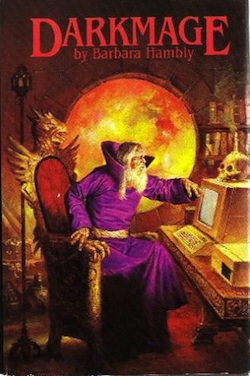The Silent Tower (1987) and The Silicon Mage (1988) make up one story; you don’t want to get caught without the second half. They have been published together as “Darkmage” and they are also known as the Windrose Chronicles. The great thing about them is not that the evil wizard is trying to implement his brain in CP/M, but that to do this, he’s invented a computer that makes electricity by draining joy out of the world. Two worlds, actually, our world and the world of Ferryth, a fantasy world just at the beginning of an Industrial Revolution.
The thing Hambly is flat out awesome at is worldbuilding. Her worlds always feel absolutely real and solid with every detail thought through and meshing with every other detail, without slowing the story down in the least. She integrates magic and technology and social attitudes to magic so seamlessly that the way things work feels like information you’ve always had. I first read these books when they came out, waiting breathlessly for the second one, and I have re-read them regularly ever since with continuing pleasure.
The computer stuff is badly dated, but it honestly doesn’t matter. I think it’s interesting that we have these moments of computer history preserved in fantasy but not in SF or mimetic fiction. Like Tea With the Black Dragon (post) we have a very specific time and technology—CP/M running on a mainframe, files transferred on floppy disks, hacking, and programming an evil wizard’s brain in lines of code. Nobody would try this now, not even the dark mage. (Of course, I used to have a Win95 computer called Suraklin…)
There are two point-of-view characters here, Joanna, a programmer from our world, and Caris, a sasenna from the fantasy world. A sasenna is a trained warrior who is supposed to be a human weapon, to do as they are told without thinking for themselves. But Caris loves his grandfather the archmage, and Caris can’t always blindly obey. Caris is completely at home in the fantasy world. For Joanna, once she’s kidnapped and dragged through, it’s all strange. She’s a great heroine, smart, fast and honest. She thinks like a programmer, breaking it all down into subroutines. She makes good plans even when they don’t work. Just having a strong clever female protagonist isn’t the relief it was in 1987, but she remains terrific. She rescues people far more often than she is rescued. And between books, back in our world, she does exactly what I always think people dragged into fantasy world ought to do—she learns weapons and finds out all she can about what’s going on.
Of course, the best thing about the books is the slightly mad wizard Antryg Windrose. He’s funny and interested in everything. He believes that all the wisdom in the world is encoded on the shells of tortoises. He wears glasses that are always having misadventures. He’s the only person who knows what’s going on and the slow way Joanna comes to care for him is done perfectly. There’s real suspense around whether he can be trusted. Antryg is sufficiently awesome that I’ll forgive the diptych the deus ex machina ending—actually, it always helps, if you have to have a deus ex machina, to have the characters remark on the deus ex machina nature of events. And it’s not the climax, anyway, it’s only what happens after the end.
There is a third book, called Dog Wizard. I read it about every third time I read the original two, when I’ve forgotten what’s wrong with it, which is that it gives Antryg a point of view and locks Joanna up helpless for most of the book. Antryg seen from outside is adorable. From inside, well, he has his moments, but he really doesn’t work anything like as well. Dog Wizard is a standalone book with a different plot, it isn’t necessary for enjoyment of the Darkmage books.
Whenever I read Dog Wizard, as well as on other occasions unrelated to the other books, I always also read Stranger At The Wedding (post), because there’s a line in Dog Wizard about Antryg seeing some wards drawn by a young lady of upper bourgeois origin from Angelshand who has never been in love. He can tell that from seeing the way she draws chalk lines—and it always makes me want to read Kyra’s own story. So I had a whole immersive orgy of Hambly and I’m not at all sorry.
I think The Silent Tower and The Silicon Mage are the best of Hambly’s earlier work, and the ones that stand up best to re-reading. I don’t want more about these characters or in this world, I want her to make up new worlds that are this good and this solid.
Jo Walton is a science fiction and fantasy writer. She’s published two poetry collections and nine novels, most recently the Nebula winning Among Others. She reads a lot, and blogs about it here regularly. She comes from Wales but lives in Montreal where the food and books are more varied.










